Bennemann K.H., Ketterson J.B. Superconductivity: Volume 1: Conventional and Unconventional Superconductors; Volume 2: Novel Superconductors
Подождите немного. Документ загружается.

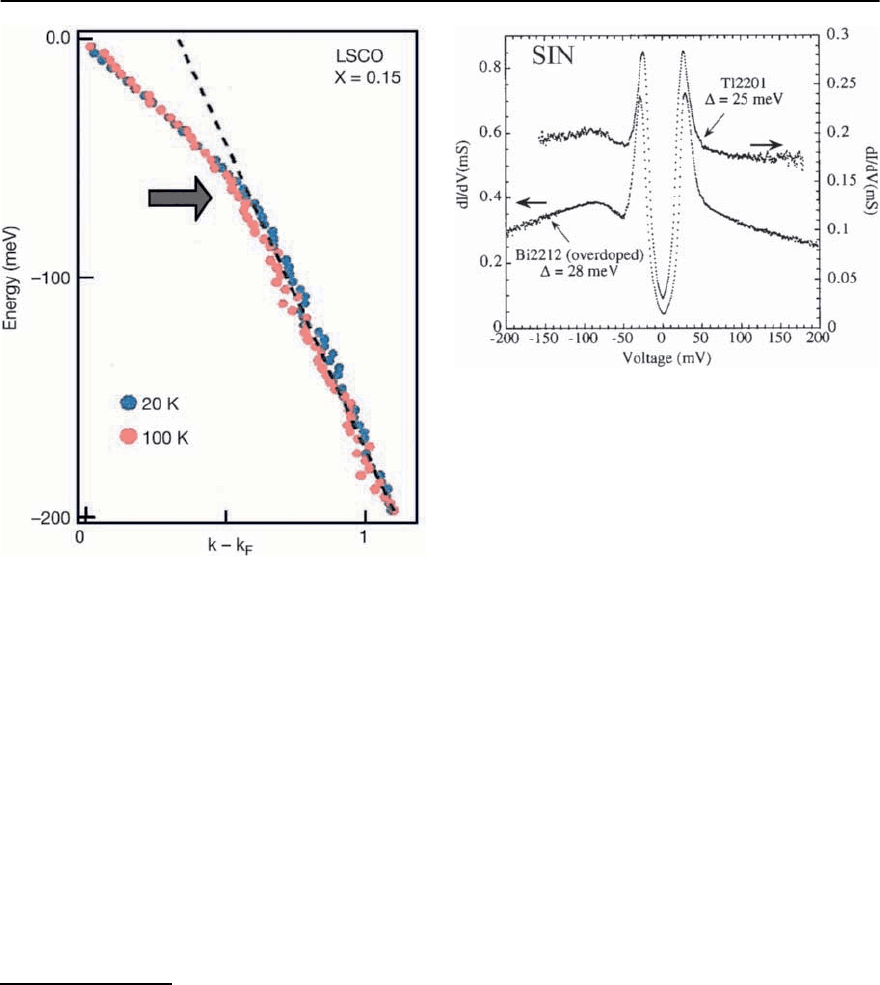
1422 D. Manske,I. Eremin, and K.H.Bennemann
Fig. 23.8. Energy dispersion !(k − k
F
) in the nodal direc-
tion with respect to the Fermi energy in the first BZ as
observed byARPES for the hole-doped cuprate compound
BISSCO at different temperatures [46] vs the normalized
momentum relative to the Fermi level. Note that the slope
of the curve gives the renormalized group velocities
Brillouin zone (BZ). One clearly sees that the curve
shows a change in its slope around 50 ± 15 meV.
This so-called “kink" feature was observed by sev-
eral groups.
2
Note, however, that bilayer effects and
matrix elements for various incident photon ener-
gies make the spectra more complicated to analyze.
Changes in the elementary excitation spectrum due
to coupling of the carriers to spin fluctuations or
other (collective) modes are generally expected. The
coupling to spin fluctuations should result in rather
Fig. 23.9. Tunneling Spectra: Comparison of SIN conduc-
tances of Tl2201 and slightly overdoped Bi2212 at T =
4.2 K. The results are taken from [49]
differentfrequency and momentum dependencies of
the self-energy than in the phonon case of coupling.
To understand this “kink” feature in detail is one
of the important problems in the theory of high-T
c
cuprates.
Note, tunneling spectroscopy allows also to deter-
mine the structure of the elementary excitations in
cuprates. Originally, the successful analysis of tun-
neling spectra in conventional superconductors like
Pb led to the common acceptance of the electron–
phonon mechanism and Eliashberg theory of su-
perconductivity [50]. Similarly, an understanding of
the structure in the tunneling spectra in high-T
c
cuprates is a central problem.
In Fig. 23.9 we show results for the super-
conductor-insulator-normal metal (SIN) tunneling
conductance (dI/dV)
s
normalized to its normal
state value for two different cuprate superconduc-
tors, Bi
2
Sr
2
CaCu
2
O
8+ı
(BISCCO) and Tl
2
Ba
2
CuO
6
(Tl2201) having two and one CuO
2
-plane per unit
cell, respectively [49]. In both cases the supercon-
2
One attempted to relate the kink feature to a coupling of the itinerant carriers to phonons, in particular, to a lon-
gitudinal optical phonon mode at 60 meV, which was observed to behave anomalously in several experiments [47].
However, this interpretation has several disadvantages. The first one relates to the fact that the inelastic scattering rate
in hole-doped cuprates is linear with frequency or temperature (whichever is larger), which can be hardly explained
using conventional electron–phonon coupling. Also in electron-doped cuprates there is no kink present [48] and the
electronic part of the resistivity follows a quadratic behavior at low temperatures indicating conventional Fermi-liquid
behavior. It is not clear how both features can be explained assuming the same electron–phonon coupling.
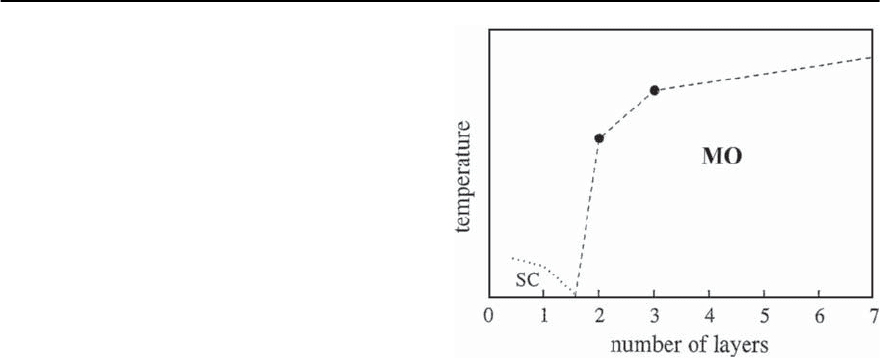
23 Electronic Theory for Superconductivity 1423
ducting gaps and T
c
are demonstrating the essen-
tial independence of the observed features on the
number of CuO
2
-layers. Notice again the non-s-wave
character of the superconducting gap, since the tun-
neling spectra have a characteristic V-shape indicat-
ing a presence of states inside the superconducting
gap.In addition, further important details are related
to the pairing interaction. Immediately after the co-
herence peak a“dip-hump”structure is present with a
“dip”approximately at energy 3
0
,where
0
is the su-
perconducting gap at T =0.Thisstructureisasym-
metric with respect to the zero bias, since it occurs
only below T
c
. It is natural to suggest that the ob-
served structure results from the pairing interaction
and reflects the important frequency range of the
spin fluctuations relevant for Cooper-pairing. One
has to understand the relation of the“dip-hump”fea-
ture to the “kink” structure seen by ARPES in order
to connect both experiments with each other.
This summarizes some key facts about super-
conductivity in hole-doped and electron-doped
cuprates. We will present an electronic theory for
the central problems by studying the interaction be-
tween carriers and spin excitations. Our theory is
able to explain basic and characteristic features in
the normal and superconducting state of cuprates
including the kink seen in ARPES and the resonance
peak observed in INS experiments.
Ruthenates
Let us describe now essential properties of Cooper-
pairing in Sr
2
RuO
4
. Superconductivity and mag-
netic activity in the ruthenates seem intimately re-
lated. The character of the magnetic activity is still
being discussed. In view of triplet Cooper-pairing
one expects that ferromagnetic spin fluctuations are
present in Sr
2
RuO
4
. This is indirectly confirmed by
the results shown in Fig. 23.10 where we plot a
schematic phase diagram of the ferromagnetic and
superconducting members of the Ruddlesen–Popper
series (Sr
n+1
Ru
n
O
3n+1
) as a function of the num-
ber of RuO
2
-layers per unit cell, n.Theinfinitelayer
(SrRuO
3
) is a ferromagnet with T
Curie
≈ 165 K. For
n =3onefindsT
Curie
≈ 148 K and for n =2
T
Curie
≈ 102 K. This demonstrates the tendency that
Fig. 23.10. Schematic phase diagram of the ferromagnetic
and superconductingsystems(Rodllesen–Popper crystals)
Sr
n+1
Ru
n
O
3n+1
,taken from [51].The number of layers is the
parameter that determines the transition between the two
phases: MO = magnetically ordered and SC = supercon-
ducting
T
Curie
is reduced with decreasing layer number n.
This suggests that even for n = 1,when superconduc-
tivity occurs, one expects significant ferromagnetic
fluctuations. These may play an important role for
superconductivity in Sr
2
RuO
4
.
Similar to the case of cuprates, inelastic neutron
scattering (INS) studies have revealed the formation
of strong incommensurateantiferromagnetic fluctu-
ations (IAF) for the wave vector Q=(2/3, 2/3)
at energy !
sf
= 6 meV [52] and no signature of
ferromagnetic fluctuations. In addition, results for
the spin susceptibility (q, !) obtained by means
of NMR [53] indicate a remarkable temperature-
dependent magnetic anisotropy; for an illustration
see Fig. 23.11.
In general,the spin-lattice relaxation as measured
by NMR allows one to study different components
of the magnetic susceptibility like their transverse
and longitudinal parts. One finds that at room tem-
perature all components are the same. Then, for de-
creasing temperature, an isotropic response in the
ruthenates is observed.Upon coolingthe spin-lattice
relaxation starts to differ and the anisotropy reaches
a maximum at T = T
c
. Therefore, at low tempera-
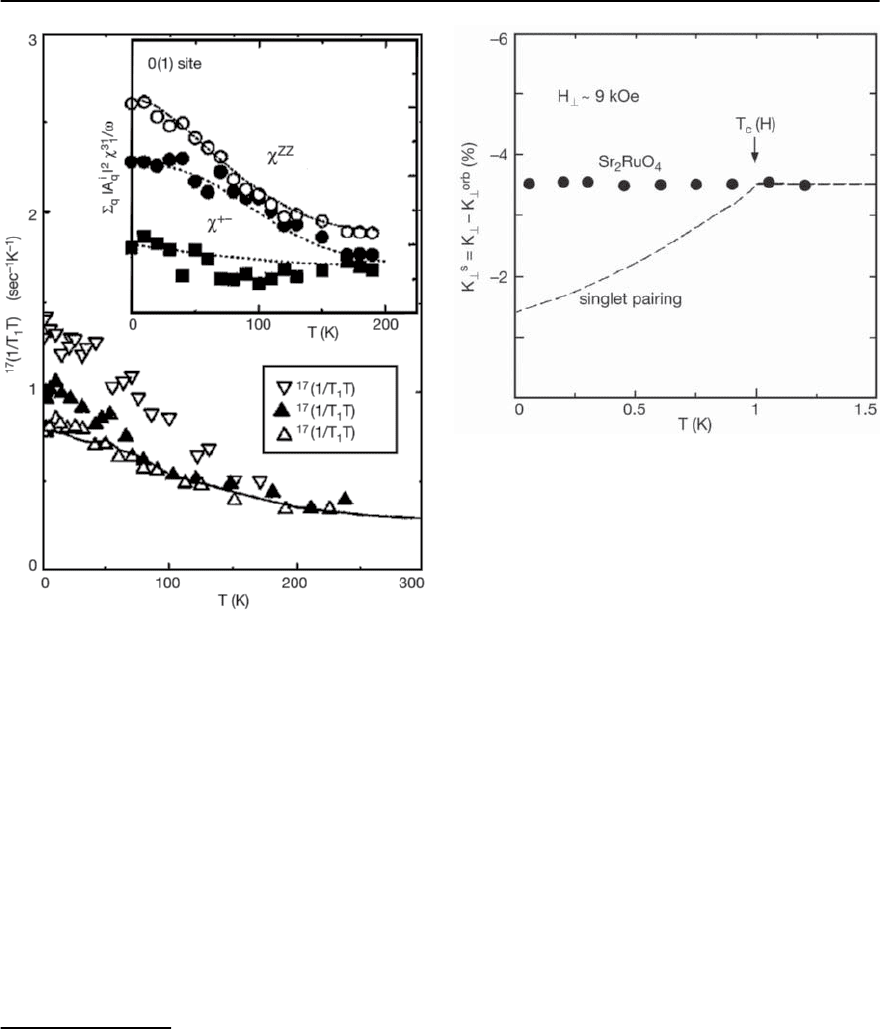
1424 D. Manske,I. Eremin, and K.H.Bennemann
Fig. 23.11. Anisotropicmagneticresponse of a single RuO
2
-
plane in the triplet superconductor Sr
2
RuO
4
vs temper-
ature as observed by NMR experiments [53]. Note that
the data are displayed only for the normal state, i.e. T ≥
T
c
=1.5 K. Results are shown for the spin-lattice relax-
ation on the oxygen nuclei
17
OintheRuO
2
-plane in terms
of (T
1
T)
−1
.Intheinset the results for the corresponding
components of the spin susceptibility (transverse and lon-
gitudinal ones) are shown indicating the increase of the
magnetic anisotropy upon cooling.
zz
and
+−
refer to
the response of the system to the external magnetic field
parallel and perpendicular to the RuO
2
-plane, respectively
tures one expects that magnetic anisotropy plays an
important role for Cooper-pairing.
What happens in the superconducting state? In
Fig. 23.12 we show experimental results suggesting
Fig. 23.12. Results for the uniform spin susceptibility,
(q =0, ! = 0) in the superconducting state of cuprates
(YBa
2
Cu
3
O
7
, dashed curve) and ruthenates measured by
NMR
99
Ru Knight shift [53].One can clearly see that in con-
trast to the singlet Cooper-pairing where the spin suscep-
tibilitydecreases upon cooling,theKnight shift in Sr
2
RuO
4
is unchanged by lowering T below T
c
.Inthecaseoftriplet
Cooper-pairing the Knight shift does note decrease below
T
c
,since the polarization induced by the external magnetic
field does not change in the superconducting state
triplet Cooper-pairing in Sr
2
RuO
4
. In conventional
superconductors the spin part of the Knight shift
measured by NMR decreases rapidly below T
c
due
to formation of singlet Cooper-pairs. On the other
hand, in a triplet superconductor with S =1thespin
part of the Knight shift should not change below T
c
,
since the polarization induced by the weak external
magnetic field and probed by NMR does not change.
This behavior was observed in Sr
2
RuO
4
by Ishida
et al. [53] and provides evidence for triplet Cooper-
pairing.
3
Note that shortly after this discovery p-wave sym-
metry of the superconducting order parameter and
triplet pairing was suggested by Sigrist and Rice [54]
3
Although one has to wait for further decisive and unambiguous evidence for spin-triplet Cooper-pairing from in-
plane
17
Oand
99
Ru Knight shift data, it is important to note that H
||
c2
(parallel to the c-axis) is too small for NMR
measurements. Therefore, strictly speaking the present Knight shift data do not fully reinforce Sr
2
RuO
4
to be a triplet
superconductor. In order to complete the picture, further studies, for example tunneling experiments along the c-axis,
are necessary.

23 Electronic Theory for Superconductivity 1425
using a phenomenological theory and some analo-
gies between the normal state of
3
He and Sr
2
RuO
4
.
Inthecaseofp-wavepairingonehas
p
=
0
(k
x
+ ik
y
) , (23.4)
and thus an order parameter where || has no line
nodes. Yet it must be remarked that the microscopic
theory of triplet Cooper-pairing in Sr
2
RuO
4
is still
under discussion [55].
In general, assuming an exchange of magnetic
fluctuations as responsible for Cooper-pairing like
in cuprates, the structure of the spin susceptibility
(q, !) and the Fermi surface topology should con-
trol the superconductivity in the ruthenates. Note
that ferromagnetic spin fluctuations dominating
over antiferromagnetic ones will cause then triplet
paring. This is analogous to the case of triplet pair-
ing in superfluid
3
He in which p-wave symmetry is
present.
The behavior mentioned above, i.e. the magnetic
anisotropy, temperature dependence of the Knight
shift as well as of the specific heat and other prop-
erties, and of the electronic structure (Fermi surface
topology) are important characteristics of Sr
2
RuO
4
and essential for an electronic theory.
Electronic Theory
Obviously, it is of great interest to have an elec-
tronic theory explaining the important normal state
behavior and the pairing mechanism for supercon-
ductivity in cuprates and ruthenates. In this article
we present results obtained by using a Hubbard-like
model Hamiltonian and by taking into account the
coupling of the elementary excitations to spin fluc-
tuations (which are partially generated by the quasi-
particles itself). This coupling may play the most
important role for Cooper-pairing. Using an effec-
tive second-order perturbation theory, the interac-
tion of the electrons (or holes) and spin fluctua-
tions leads to the effective electron–electron inter-
action shown in Fig. 23.13. Applying a generalized
Eliashberg-type theory in the strong coupling limit
we describe important behavior of hole-doped and
electron-doped cuprates and Sr
2
RuO
4
.Wecompare
our results critically with experiments. Note that in
contrast to phonon-mediated superconductors no
Migdal theorem can be used [56]. In general, Trem-
blayetal.[57],andChubukovetal.[58]havestudied
the role if vertex corrections of quasiparticle cou-
ple to spin fluctuations. They have pointed out that
due to !
sf
/E
F
∼ 10
−2
and a flat dispersion around
(, 0) they do only change the magnitude of the ef-
fective Coulomb interaction U,butthedynamicsof
vertex corrections may be neglected (U → U
eff
).
Note that in the optimally and overdoped cuprates
the vertex corrections are small and have positive
sign of the Eliashberg coupling. This even enhances
the coupling to spin fluctuations [59], but in un-
derdoped cuprates the vertex corrections may be-
come important. However, simply speaking, as long
as U(q, !) < 1,perturbation theory forconstruct-
ing a pairing potential in the paramagnetic phase
should work, unless poles of the bosonic mode (i.e.
in ) enhance the pair-breaking contribution of the
vertex function drastically.
4
Concerning the dynam-
ics, note that the pairing potential is mediated by
the same quasiparticles that form the Copper-pairs.
Therefore, one has to solve this many-body prob-
lem self-consistently. As we will discuss below, the
spin susceptibility , resulting from d-electrons of
Cu, and the gap function that is dominated by a hy-
bridization of p-electrons and d-electrons, strongly
interact with each other. Thus, in general one has
coupled equations for {G, } and {G, } where G
is the Green’s functionof the corresponding electron.
Note that in a simple spin–fermion model the feed-
back of the elementary excitations on the pairing po-
tential is neglected [58]. Simply speaking, electrons
(holes) do not only condense into Cooper-pairs, but
are also involved in the magnetic activity. Thus, a
self-consistent treatment is indeed required.
By employing the trial-and-error principle we
hope to find the correct route for a theory that may
play the same role as the BCS theory for the case of
electron–phonon interaction with s-wave symmetry
singlet Cooper-pairing. Of course, not only the dop-
4
If so,then the usual perturbation theory breaks down [60] and a non-perturbative approach has to be used as suggested
for example in [61].

1426 D. Manske,I. Eremin, and K.H.Bennemann
Fig. 23.13. Feynman diagram representing for the cuprates
and ruthenates the coupling of the carriers described by
Green’s function G (G
0
= bare propagator) to magnetic spin
fluctuations described by the spin susceptibility (q, !).
U (U
eff
) is an effective (renormalized) coupling constant
that includes vertex corrections
ing dependence of superconductivity in the cuprates,
but also that of the elementary excitations and of
the spin susceptibility (q, !)areimportantprob-
lems to investigate. Cuprates and ruthenates, behave
differently due to the differences in their electronic
properties. Of course, the electronic structure, the
energy dispersions and resultant Fermi surface will
playanimportantroleasinputforthecalculations.
We will see later that in an effective one-band de-
scription of the itinerant quasiparticles the coupling
constant U (see Fig. 23.13) and a tight-binding en-
ergy dispersion will be the only parameters that enter
the theory.
Basic Electronic Structure
For all cuprate compounds (both hole-doped and
electron-doped) the degeneracy between 3d-orbitals
is removed by the lattice structure. After some
straightforward calculations it can be shown (see
Fig. 23.14(a)) that the hybridized copper and oxygen
orbitals separate. The state with highest (lowest) en-
ergy has mainly d
x
2
−y
2
-wave character. The missing
electron (i.e.a hole) givesthe Cu-ion a spin
1
2
.Thus,in
the absence of doping,the cuprate material is well de-
scribed by a model of mostly localized spin-
1
2
states.
The other orbitals are occupied and therefore can be
neglected. However, the strong Coulomb repulsion
between holes in the same orbital has so far not been
taken into account and must be included.
5
Due to
largeCoulomb repulsion d
x
2
−y
2
-orbitalssplit intotwo
so-called lower and upper Hubbard bands (LHB and
UHB), respectively, as shown in Fig. 23.14(b). Then,
at half-filling the system becomes an insulator. Fur-
thermore, due to a very large U
d
the splitting of the
d
x
2
−y
2
-band is so large that the oxygen p-bandlies be-
tweentheUHBandtheLHB.Thechargetransfergap
in cuprates ı (ı =
p
−
d
) is smaller than U
d
[62,63].
This has a very interesting consequence for the
doping of the CuO
2
-plane with holes or electrons.
Due to the large Coulomb repulsion the doped hole
is mainly in the oxygen p-band. Therefore, in hole-
doped cuprates the carriers (holes) occupy mainly
hybridized oxygen p-states.On the contrary,electron
doping means effective doping of the d
x
2
−y
2
-orbital
in UHB. Thus, the carriers in the electron-doped
cuprates sit largely at Cu 3d-sites.
Figure 23.14(b) suggests that hole-doped and
electron-doped cuprates may under certain assump-
tions be mapped on to an effective one-band Hub-
bard model. The difference between hole and elec-
tron doping will be reflected by the different param-
eters of the model and differences of the character
of the involved orbitals of the hybridization between
p-states and d-states. For hole doping the Fermi level
lies in the p-band and for electron doping in UHB.
The spin at Cu-sites will induce a spin polarization
at the neighboring oxygen sites upon hole doping
(see the Zhang–Rice singlet formation). This is not
thecaseforelectrondoping(atCu-sites)inwhich
a dilution of the spin system occurs. On the other
hand, in hole-doped cuprates one decreases effec-
tively only the number of Cu-spins and the system
becomesmoreitinerant.Consequently,one gets adif-
ferent behavior of (q, !) and different doping de-
pendence of antiferromagnetism in the hole-doped
and electron-doped cuprates.
Similarly as for the cuprates we use also
a Hubbard-like Hamiltonian for the ruthenates
(Sr
2
RuO
4
). However, we include three bands (˛, ˇ,
) crossing the Fermi-level into the calculations. In
Sr
2
RuO
4
the formal valence of the ruthenium ion is
Ru
4+
. This leaves four electrons remaining in the 4d-
shell. Furthermore, the Ru ion sits at the center of
5
Actually neglecting interactions, one would have expected La
2
CuO
4
to be metallic with a half-filled conduction band.
As we know this is not true and this material is an antiferromagnetic insulator. Therefore, double occupancy should be
energetically not favorable due to Coulomb repulsion.
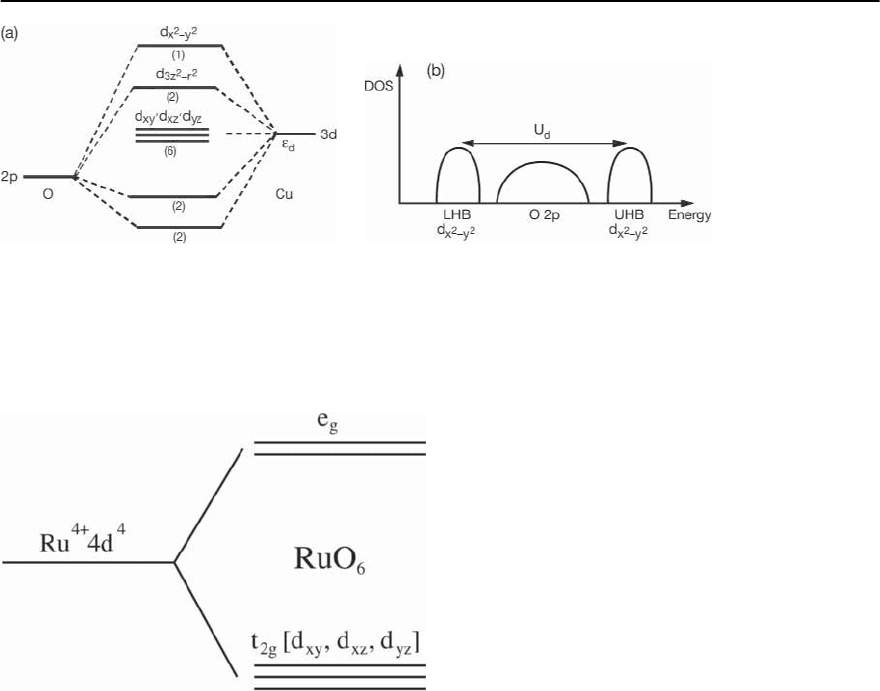
23 Electronic Theory for Superconductivity 1427
Fig. 23.14. SchematicelectronicstructureofCuO
2
-planes reflecting bonding between a Cu
2+
and two O
2−
ions. (a)Initial
splitting of the bands taking into account crystal field interaction only.We consider only d-electrons (holes) of Cu and p
x
and p
y
orbitals of the oxygen. The numbers indicate the occupations of the different levels in the undoped compound.(b)
Roleof the on-site Coulomb repulsion and the splittingof the 3d
x
2
−y
2 -orbital into a lower (LHB) and upper Hubbard band
(UHB).U
d
is the Coulomb repulsion between electrons at Copper.Due to ı =
p
−
d
< U
d
the cuprates are Mott–Hubbard
insulators without doping
Fig. 23.15. Electronic structure of Sr
2
RuO
4
.TheRu
4+
ion
corresponds to a 4d
4
level. The splitting of the e
g
and t
2g
subshells is due to the RuO
6
crystal field. The orbitals d
xy
,
d
xz
,andd
yz
cross the Fermi level.Magnetic activity results
from the t
2g
subshell. The RuO
2
-plane structure plays an
important role
aRuO
6
-octahedron and the crystal field of the O
2−
ions splits the five 4d-states into threefold (t
2g
)and
twofold (e
g
) subshells as illustrated in Fig. 23.15. The
negative charge of the O
2−
ions causes the t
2g
sub-
shell to lie lower in energy. Note that these orbitals
(xz, yz,andxy) have lobes that point between the
O
2−
ions lying along the x, y,andz-axes. Electrons
of these orbitals form the Fermi surface and as we
have already mentioned the ˛, ˇ,and -bands. We
again assume that the most important interaction of
the carriers is with spin excitations described by the
spin susceptibility (q, !) and resulting from Ru ˛,
ˇ,and -states.
To explain the experimentally observed large
anisotropy of the magnetic activity in the RuO
2
-
plane, see
+−
(q, !)and
zz
(q, !) along the z-
direction perpendicular to the planes, we include
also spin–orbit coupling for the significant ˛, ˇ,
and -bands.Again,we hope that our trial-and-error
type philosophy and critical comparison with exper-
iments will help us to find the correcttheory and will
explain triplet superconductivity.
Summary
In summary, by using a Hubbard-like Hamiltonian
we attempt to describe the electronic properties
of the layered superconductors Cu-oxides and Ru-
oxides. The theory for spin excitation-mediated su-
perconductivity in cuprates and ruthenates may also
help us to find a theory for the other novel supercon-
ductors such as the heavy-fermion ones, ZrZn
2
,UPt
3
,
UGe
2
,etc.
In the next sections we describe the electronic the-
ory for calculating (a) the elementary excitations,the
self-energy and spectral density; (b) the spin suscep-
tibility (q, !); and (c) superconductivity and the
symmetry of the superconducting order parameter.
We present results for various important properties.
Finally,we discuss the limitationof our model forthe
cuprates and ruthenates and give an outlook.

1428 D. Manske,I. Eremin, and K.H.Bennemann
23.2 Electronic Theory for H ole-Doped
and Electron-Doped Cuprates
We present now the theory for the interaction be-
tween quasiparticles and spin fluctuations in the
cuprates and in Sr
2
RuO
4
. For simplicity we assume
that the electronic dynamics is controlled by the
CuO
2
and RuO
2
-planes, respectively.
For the description of singlet superconductivity
in the cuprates we use a one-band model Hamilto-
nian.The interaction between the carriers (quasipar-
ticles) is described by an effective Coulomb coupling
U and the itinerancy of the carriers by a hopping in-
tegral t.We assume that these can be describedby the
effective one-band with U. In the case of hole dop-
ing the states of the effective band are mainly the
p-states originatingfrom O-atoms. The spin fluctua-
tionsarisefromthe magnetic activity oftheCu-spins
and the induced spin polarization of the p-states. In
the case of electron doping the effective one-band
Hamiltonian describes the hybridized d-states of the
UHB(seeFig.23.14(b)) andU is an effective coupling
between the electrons in these states. The spin fluc-
tuations result from the Cu-spins. Upon doping the
Cu-spins are quenched and the spin polarization of
the band is reduced.We assume itinerant magnetism
for the UHB. We will see later from a comparison of
the theoretical results with experiments in the opti-
mally and overdoped case that this is a useful model.
For describing Cooper-pairing in Sr
2
RuO
4
we
also employ a Hubbard Hamiltonian. In contrast to
cuprates no doping occurs. In order to derive an elec-
tronic theory it is important to take the electronic
band structure of the t
2g
-subshell into account and
thus to include the states of the d
xy
, d
yz
,andd
xz
-
bands that cross the Fermi level. Magnetic activity
arises from itinerant electrons in the Ru d-orbitals.
Due to a different topology of the corresponding
Fermi surfaces a strong magnetic anisotropy occurs
(
+−
>
zz
) in the normal state. This mainly results
from different values of the g-factor for the trans-
verse and longitudinal components of the spin sus-
ceptibility (i.e. the matrix elements differ) and from
a change of the bare energy dispersion of the d-
electrons. Obviously,this will have consequences for
the symmetry of the superconducting order param-
eter. In order to describe this magnetic anisotropy,
one must also take into account spin–orbit coupling.
23.2.1 Electronic Structure and the Hamiltonian
In the case of the cuprates the calculation of the elec-
tronic properties is complicated due to strong elec-
tronic correlations.
6
In order to account for these we
use a simplifying model that includes the states orig-
inating from the CuO
2
-planes and play the most sig-
nificant role. First, we neglect interlayer coupling of
CuO
2
-planes.
In Fig. 23.16 we show the electronic structure of
aCuO
2
-plane. The undoped case corresponds to a
half-filled band, i.e. one hole per copper site. The
holes mainly occupy the d
x
2
−y
2
-orbitals and interact
with each other via superexchange yielding an anti-
ferromagnetic ground state. Due to a large Coulomb
repulsion U = U
d
further holes that are doped into
the CuO
2
-plane are mainly placed on the four oxygen
p-states surrounding the copper sites. Thus, the cen-
ter of mass of these new quasiparticles is still located
on the copper sites. Obviously, the spin polarization
of the doped holes tends to suppress the antiferro-
magnetism. In addition, spin frustration takes place
for small hole-doping.
In the case of electron-doped cuprates the doped
carriers directly occupy copper d
x
2
−y
2
-states. There-
fore, the antiferromagnetism is weakened by diluting
the copper spins. No spin frustration occurs.
Finally, after doping a reasonable number of car-
riers into a CuO
2
-plane, in both cases, electron or
hole doping, one ends up with a non-ordered para-
magnetic (metallic) phase that still reveals (short-
range) antiferromagnetic correlations. The resulting
spin excitations are responsible for singlet Cooper-
6
As we know from the experiment the parent cuprate compounds are antiferromagnetic insulators.At the same time by
applying a local-density-approximation calculation on undoped cuprates one finds that the system should be metallic
with one hole per unit cell that satisfies the formal valencies of La
3+
,O
2−
,andCu
2+
[64] that is inconsistent with
experiment.The neglection of the electronic correlations due to strong local Coulomb repulsion is responsiblefor this.
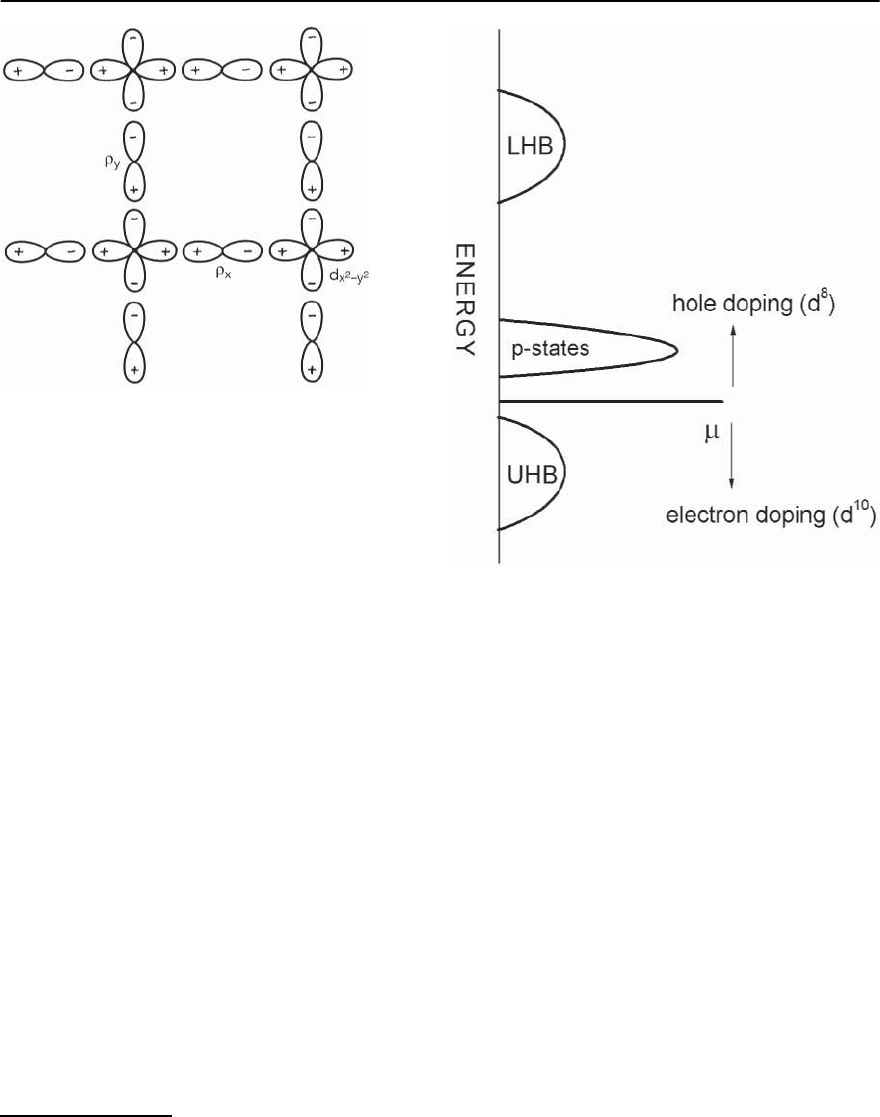
23 Electronic Theory for Superconductivity 1429
Fig. 23.16. Schematic representation of the electronic struc-
ture of a single CuO
2
-plane consistingof Cu d
x
2
−y
2 -orbitals
and the oxygen p
-orbitals. Without doping one hole is
present in the Cu d
x
2
−y
2 -orbital.Via hybridization with oxy-
gen (i.e.superexchange) p-orbitals of two neighboring cop-
per holes interact antiferromagnetically. This leads to an-
tiferromagnetic ordering of the Cu-spins. The doped holes
are mainly in the oxygen p-orbitals due to a large Coulomb
repulsion U = U
d
and destroy antiferromagnetism of the
copper spins and spin frustration occurs. In contrast to
this, doping the CuO
2
-plane with electrons means effec-
tively occupation of the UHB band and dilution of the
Cu-spins and thus weakening of the antiferromagnetism
pairing in the cuprates. In our electronic theory we
assume that these can be described mainly by itiner-
ant carriers.
7
We start by using the three-band Hubbard-like
model [65]
H =
d
i,
d
+
i
d
i
+
p
i,
p
+
i
p
i
(23.5)
+
i,j,
t
ij
pd
d
+
i
p
j
+h.c
+
i,j,
t
ij
pp
p
+
i
p
j
+h.c
+ U
d
i
n
d
i↑
n
d
i↓
+ U
p
i
n
p
i↑
n
p
i↓
+ U
pd
i,j
n
p
i↑
n
d
j↓
for describing the hole-doped and electron-doped
cuprates.Here,the sums are performed over the cop-
per and oxygen lattice positions both labeled by i
Fig. 23.17. Illustration of the hole and electron doping in
cuprates. Without doping due to strong electronic correla-
tions the chemical potential lies between the upper Hub-
bard band (UHB) of the copper d
x
2
−y
2 -orbital and oxygen
p-states. Upon hole doping the chemical potential shifts
towards the oxygen p-band leading to an insulator–metal
transition. In the case of electron doping the chemical po-
tential lies in the copper UHB.Notethat the lower Hubbard
band (LHB) of d
x
2
−y
2 -states is separated largely in energy
from the oxygen p-states due to U
d
ı, ı =
p
−
d
and refers to the spin.t
ij
˛ˇ
describes the hopping be-
tween the sites i and j and states ˛ and ˇ.n
d
i
= d
+
i
d
i
and n
p
i
= p
+
i
p
i
are the Cu 3d and O 2p hole densi-
ties for site i, respectively. U
d
and U
p
refer to on-site
copper and oxygen Coulomb repulsion, respectively,
and U
pd
accounts for the copper–oxygen interaction.
As we have discussed above, due to strong elec-
tronic correlations the undoped cuprates are an-
tiferromagnetic insulators. The chemical potential
lies between the upper Hubbard band of the d
x
2
−y
2
-
orbitaland oxygen p-band (see Fig.23.17 for an illus-
7
We assume that the Cu-spins are part of the p − d hybridized states.

1430 D. Manske,I. Eremin, and K.H.Bennemann
tration).Uponhole dopingthe chemicalpotentiallies
in the oxygen p-band. The latter hybridizes strongly
with copper d-states. As a result the bandwidth of
the oxygen band reduces and Zhang–Rice singlets
are formed [66]. In the case of electron doping, the
chemical potential lies in the copper upper Hubbard
band (UHB). Furthermore, due to large values of U
d
andof thecharge-transfer gap ı,thecopperUHBand
LHB are well separated in energy. This suggests the
use of an effective one-band Hubbard-like Hamilto-
nian
8
for doped cuprates:
H =−
i,j
t
ij
c
+
i
c
j
+h.c.
+ U
i
n
i↑
n
i↓
+ ...
(23.6)
describing the dynamics of holes in hybridized p-
states and of electrons in effective d-states of the
UHB. In (23.6) the c
+
i
are fermion creation opera-
tors for spin on sites i of a two-dimensional square
lattice, and n
i
= c
+
i
c
i
denotes the density for spin
. The Hubbard U describes the effective Coulomb
interaction between the quasiparticles in the con-
duction band and thus should be a good description
of the paramagnetic state with strong antiferrromag-
netic correlations.
Note that the effective interaction U might be dif-
ferent in hole-doped and electron-doped cuprates.
In the latter case both itinerant behavior and mag-
netism result from the electrons in the copper d-
states of the UHB. In the hole-doped case the hole
carriers are located mainly on the oxygen p-states,
and the magnetic activity arises mainly from Cu-
spins, the localized copper d-holes. These interact
with the spins of the doped holes that are present at
the oxygen sites. In (23.6) the interaction of the itin-
erant electrons with the Cu-spins results from U and
the remaining not explicitly given terms take care of
the local spin character. Note that the interaction of
local spins S
i
with itinerant carriers having spin
should be of the form (S
i
· ). For simplicity one is
tempted to simulate this in the case of hole doping
by an effective interaction between the band elec-
trons (holes).Consequently the dots in (23.6) refer to
residual interactions, for example resulting from the
local character of the Cu-spins.
Using this physical picture we develop the Eliash-
berg theory for Cooper-pairing in hole-doped and
electron-doped cuprates. First, we rewrite the effec-
tive one-bandHubbard Hamiltonian for the itinerant
carriers in momentum space:
H =
k
k
c
†
k,
c
k,
+
U
2
kk
q
c
†
k,
c
†
k
,−
c
k
+q,−
c
k−q,
,
(23.7)
with the one-band electron (or hole) energy
k
=−2t
cos(k
x
)+cos(k
y
)
−2t
cos(k
x
)cos(k
y
)+
2
. (23.8)
From now on the coupling constant U denotes an ef-
fective interaction for the carriers in the p − d-states
including largely the effects due to (S
i
· ). For a de-
scription of the itinerant quasiparticles we assume
nearest neighbor and next nearest neighbor hopping
described by t and t
, respectively. Here and in the
following we set the lattice constant equal to one.
Note that the general form of the unrenormalized
tight-binding energy dispersion is the same for holes
and electrons,but with different parameters used for
t and t
. These have to be chosen in agreement with
the experimentally observed Fermi surface in hole-
doped and electron-doped cuprates.
23.2.2 Eliashberg Theory for the Interaction Between
Quasiparticles and Antiferromagnetic Spin
Fluctuations
In general, the interaction between the carriers and
spin fluctuations in the cuprates is given by
H
int
=
q
˜
U
eff
(q)
−→
s (q)
−→
S (−q) . (23.9)
Here,
˜
U
eff
denotes the effective coupling and s(q)is
the spin operator of the itinerant carriers,
−→
s (q)=
1
2
k
c
+
k+q,
c
k,
, (23.10)
8
Note, the validity of the effective one-band Hamiltonian for the hole-doped cuprates has been also justified from a
microscopic consideration of Baumg¨artel, Schmalian and Bennemann [67] on the basis of p − d Hamiltonian using a
slave-boson technique [68].

23 Electronic Theory for Superconductivity 1431
where represents the Pauli matrices.S(Q)isthespin
operator referring to the Cu-spins. The correspond-
ing spin–spin correlation function gives the dynam-
ical spin susceptibility,(q, !). Due to itinerancy of
the Cu spin electrons the susceptibility may be de-
terminedby therandomphase approximation (RPA).
Then,
RPA
(q, !)=
0
(q, !)
1−
˜
U
0
(q, !)
. (23.11)
Here,
0
is the bare spin susceptibility which is de-
fined via retarded Green’s functions for the quasipar-
ticles creating the spin excitation. Then, in second-
order perturbation theory the effective interaction
between carriers has the form (see Fig. 23.13):
V
eff
=
˜
U
eff
RPA
(q, !)
˜
U , (23.12)
where
˜
U
eff
and
˜
U refer to the coupling between
the carriers and the spin excitations. The Hubbard-
like interaction
˜
U
eff
includes vertex corrections
whereas
˜
U denotes the effective coupling. Then, the
Eliashberg-like system of equations for a supercon-
ductor are given by the Green’s function (G
−1
=
G
−1
0
− £) with self-energy:
£(k, !)=
˜
U
eff
˜
U
k
!
RPA
(k − k
, ! − !
)
× G(k
, !
) (23.13)
and anomalous self-energy
¥ (k, !)=−
˜
U
eff
˜
U
k
!
RPA
(k − k
, ! − !
)
× G(k
, !
) G(−k
, −!
)¥ (k
, !
) . (23.14)
Here, £(k, !) is the self-energy of the one-particle
Green’s function G(k, !) in the normal state and
¥ (k, !)=(k, !)Z(k, !) is the corresponding
anomalous part. The superconducting order param-
eter is (k, !). Z(k, !) denotes the renormalization
function describing the effective mass of the quasi-
particles. We employ the Dyson equation yielding
G(k, !)=
1
! −
k
+ − £(k, !)
≡ G(k) . (23.15)
This system of equations allowsone to find the super-
conducting gap and the superconducting transition
temperature T
c
(defined throughafiniteoff-diagonal
self-energy,i.e.(T < T
c
) = 0).The spin fluctuations
and (q, !)wouldactasaninput.
Note that on the RPA level also the charge fluc-
tuations are included. This may be of interest if a
charge-density-wave (CDW) or stripe formation oc-
curs. Both may compete for small doping. The su-
perposition of spin and charge fluctuations leads to
=
c
+
s
with
c
RPA
(q, !)=
0
(q, !)
1+
˜
U
0
(q, !)
. (23.16)
Then, in the Nambu representation [69] the 2 × 2
matrix £(k) is given by the expression
£(k)=
k
V
s
(k − k
)
0
G(k
)
0
+
k
V
c
(k − k
)
3
G(k
)
3
, (23.17)
where
˛
(˛ =0, 1, 2, 3) are the Pauli matrices and
V
s
and V
c
are the matrix elements of the electron–
electron interaction due to spin and charge fluctua-
tions shown in Fig.23.18.Omittingthe firstdiagram,
since it yields a shift in thechemical potential (non-
retarded) and has no d-wave contribution, one finds
V
s
(q)=
3
2
˜
U
eff
˜
U
s
(q),
V
c
(q)=
1
2
˜
U
eff
˜
U
c
(q) , (23.18)
where
s
and
c
are the dynamical spin and charge
(dielectric) susceptibilities which within RPA are
given by
s
(q)=
s0
(q)
1−
˜
U
s0
(q)
,
c
(q)=
c0
(q)
1+
˜
U
c0
(q)
. (23.19)
Here,
s0
(q)and
c0
(q) are the corresponding ir-
reducible parts calculated from unrenormalized
Green’s functions
9
,i.e.
0
∼
k
G
0
(k)G
0
(k + q).
9
Note that including charge fluctuations effects might be of interest in connection with lattice distortions and stripe
formation. Superconductivity and charge density wave formation may coexist to some extent in the cuprates.
